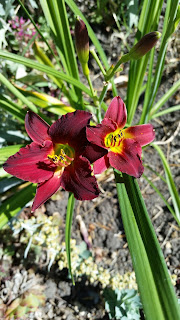My epiphytic cactus blooms every August in a mostly shaded location outside, this year was the best yet! I know, I post pics of this every year but I always find the giant blooms so amazing, this photo benefits from some interesting lighting.
I picked up this New Zealand Flax at half price, end of season sale, the tag calls it Rainbow Sunrise "Maori Sunrise" . Of course these are only hardy on the west coast of Canada, or maybe you've seen them in California too? I will try to overwinter this plant indoors and let you know how that goes. In warm climates these plants grow several feet tall so this may take several years, until then I will enjoy the vibrant colours at any size.
This Piri Piri Chili and a few other types of chilies I grew enjoyed the heat this year. Around here we are lucky to harvest chilies before frost. This one was pretty hot, very nice! I hope to write about the vegetable gardening I have undertaken this year very soon.
This pot of decorative Artemesias did very well with the heat too, the hanging bamboo does not seem to like so much intense heat however.
Shrimp Plant seemed quite at home with the heat and very regular watering, blooming almost constantly through the summer.
Cannas and Sweet Potato Vine were quite at home with the hot weather too, performing very well all summer.
I figured out if you are having an eclipse you can take a picture of the sun and while looking at he screen move your phone around a little until you get a second tiny image of the sun which will show the image of the sun backwards but you'll be able to see the progress of the eclipse. So, if you can zoom in to the tiny speck to the left of the sun in this photo you'll be able to see the eclipse at it's peak in my area. Being in South Western Canada we had 80% coverage so it did get eerily dark and chilly for a few moments there.
A view of the vegetable boxes in mid summer, there are many leafy greens we can't keep up to eating!



























































